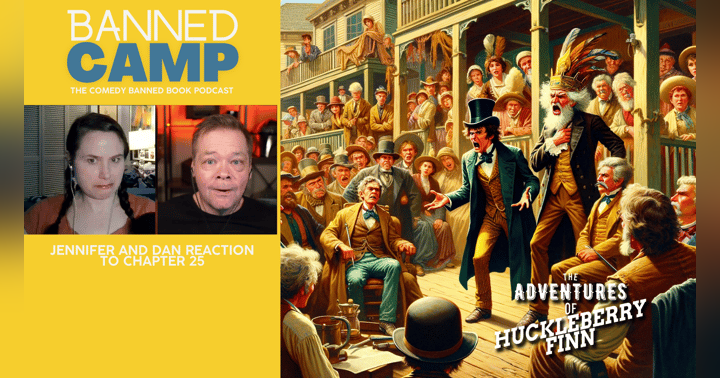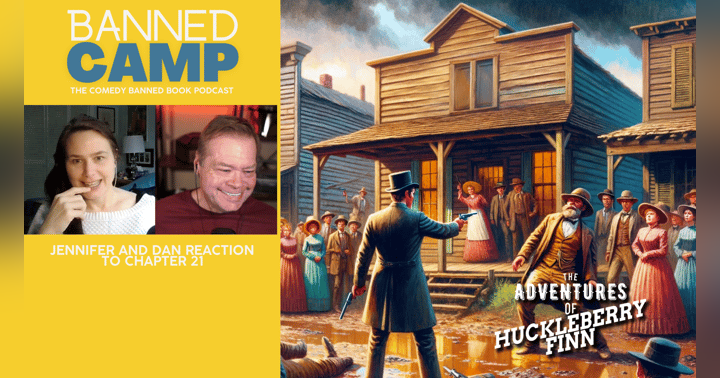Exploring Huck Finn's Second Half of Chapter 18 : Feud and Tragedy

In the latest "Banned Camp" episode, Jennifer and Dan took their listeners on a thought-provoking journey through the second half of Chapter 18 of Mark Twain's classic, "The Adventures of Huckleberry Finn." This chapter, steeped in historical context and intricate character dynamics, offers a unique window into the societal norms and conflicts of Twain's time. The episode, available at this link, not only dissects the text but also delves into its relevance and controversy in modern times.
"Banned Camp," a podcast that uniquely combines humor with literary analysis, stands out for its approach to understanding why certain books are banned. By unraveling the narrative of Huck and Jim's adventures, Jennifer and Dan shed light on the complexities of human relationships, societal conflicts, and the often arbitrary nature of censorship. This blog post aims to explore these themes further, offering readers a deeper understanding of Twain's work and the absurdity of banning such profound literature.
What Is In The Second Half of Chapter 18 Of "Huckleberry Finn"?
In this pivotal part of "The Adventures of Huckleberry Finn," Mark Twain artfully portrays the absurdity and tragedy of a longstanding feud between the Grangerfords and Shepherdsons. This chapter, discussed in detail in this Banned Camp episode, is a microcosm of the larger societal conflicts of the time. Twain masterfully uses this feud to underscore the senseless violence that can arise from longstanding grudges and societal divisions.
Huck, ever the observer, finds himself in the midst of this chaos. His experiences range from delivering a message for Sophia Grangerford, leading to an unexpected swamp adventure, to witnessing the devastating outcomes of the feud. The chapter culminates in a poignant and violent climax, where the consequences of hatred and misunderstanding are laid bare. Through Huck's eyes, we see the indiscriminate nature of violence and the loss of innocent lives, symbolized by the character Buck. For a comprehensive overview of the entire saga of "Huckleberry Finn," don't forget to catch up on all Banned Camp episodes here.
Character Development
The character arcs in the second half of Chapter 18 of "Huckleberry Finn" are a testament to Mark Twain's skill in portraying complex human emotions and societal interactions. This segment of the story, as discussed in the insightful Banned Camp episode, highlights significant developments, particularly in Huck and Jim's characters.
Huck's experiences with the Grangerfords and Shepherdsons provide him with a deeper understanding of human conflict and the futility of senseless violence. His reflections on the feud and its tragic outcomes offer a poignant commentary on the arbitrary nature of such disputes. Meanwhile, Jim's presence and actions in this chapter subtly emphasize the themes of loyalty and the search for freedom, underscoring Twain's critique of societal norms and racial injustices of the time.
The emotional depth and growth of these characters not only propel the story forward but also enhance its thematic richness. Their development is crucial in understanding the broader narrative of "Huckleberry Finn" and the societal commentary Twain weaves throughout the novel.
Themes and Symbols
Chapter 18 of "The Adventures of Huckleberry Finn" is rich with themes and symbols that resonate deeply in the fabric of American literature and society. As dissected in the Banned Camp episode, this part of the novel delves into the absurdity of entrenched conflicts, the destructiveness of blind allegiance to tradition, and the tragic consequences of societal divisions.
The Grangerford-Shepherdson feud stands as a potent symbol of the irrationality and destructiveness of human conflicts. This senseless rivalry, forgotten in origin yet continued with deadly earnestness, mirrors the larger societal conflicts of Twain's time, including the Civil War. The swamp, where Huck finds Jim, symbolizes a place of refuge and a momentary escape from the chaos of the feud, highlighting themes of freedom and the search for safety in a tumultuous world.
The chapter also employs powerful imagery to convey the stark contrast between the idyllic Southern aristocracy and the brutal reality of their existence, marred by violence and prejudice. Twain's use of irony and satire in this chapter is instrumental in critiquing the societal norms of his era, making it a significant part of the novel's overarching narrative.
Chapter's Impact on the Overall Story
The events in the second half of Chapter 18 of "Huckleberry Finn" have a profound impact on the overall narrative of the novel, marking a turning point in Huck's journey and understanding of the world around him. This chapter, discussed in-depth in the Banned Camp episode, is pivotal in advancing the plot and deepening the themes of the story.
The tragic end of the Grangerford-Shepherdson feud serves as a stark reminder of the futility and destructiveness of senseless violence. Huck's disillusionment with the feud and his resulting decision to leave underscores his growing awareness and moral development. This chapter also reinforces the bond between Huck and Jim, as they reunite and continue their journey together, symbolizing hope and resilience in the face of adversity.
Furthermore, this chapter's intense events set the stage for future conflicts and moral dilemmas Huck will face. It highlights the contrast between the innocence and integrity of Huck and Jim's friendship and the corrupt and prejudiced world they navigate, adding depth and complexity to Twain's critique of society.
Banning Triggers: Themes from this chapter
The second half of Chapter 18 in "The Adventures of Huckleberry Finn" brings to light several themes that could potentially trigger calls for its banning. As discussed in the Banned Camp episode, this chapter delves into violence, conflict, and societal critique, which can be contentious in certain contexts.
The portrayal of the brutal and senseless Grangerford-Shepherdson feud may be seen as a reflection of the harsh realities of human nature and societal divisions. This depiction of violence, while critical for understanding the novel's themes, could be misconstrued as gratuitous or inappropriate for certain audiences. Additionally, the racial dynamics and historical context of the novel, particularly in the interactions between Huck, Jim, and the Southern society, might provoke controversy, especially in environments sensitive to discussions of race and history.
However, as Jennifer and Dan recognize, these themes, while provocative, do not justify the banning of the book. Instead, they serve to enhance the novel's exploration of complex societal issues and should be viewed as an opportunity for thoughtful discussion and learning.
Conclusion
"Banned Camp," a comedy podcast where we read banned books and find out why they were banned in the first place, continues to offer insightful, humorous, and thought-provoking discussions on some of literature's most controversial works. Dive into our banned book podcast to explore more episodes, where Jennifer and Dan unpack the complexities of these narratives, shedding light on the absurdities of censorship and the richness of these literary treasures.
Further Reading
"Censorship and Mark Twain's Adventures of Huckleberry Finn" - This scholarly article examines the history of censorship surrounding the novel and offers insights into the controversies it has sparked. Read more
"Banning Books in America: A Century of Conflict" - If you're curious about the history of book banning and its impact on literature, this book by Patricia J. Scales provides a comprehensive overview. Find the book here
"Banned Books That Shaped America" - American Library Association"
Discover why "The Adventures of Huckleberry Finn" and other classic novels have faced censorship and the impact of these bans on literature. Read more










